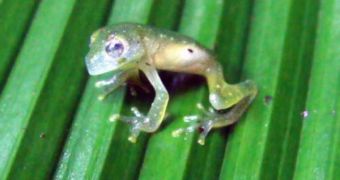If you're a naturalist looking to leave your name in the history book as the discoverer of new animal species, maybe the Tacarcuna area of the Darien, a mountainous region near the Panama border, is the right place for you to start exploring. Scientists from Conservation International (CI) and Ecotropico Foundation (EF), who have been on an expedition in the area, have recently discovered as many as ten new species of amphibians, of which three are see-through frogs, perfectly able to camouflage themselves out of harm's way.
The area has one of the largest arrays of biodiversity in the world, as the international team, who has stood there for about three weeks, has managed to identify and catalog about 60 species of amphibians, some 20 different kinds of reptiles, and 120 types of birds, several of which are apparently only indigenous to the Darien region, and cannot be found anywhere else in the world. Colombian authorities estimate that the country is home to more than 754 kinds of amphibians, and that there are potentially a lot more species that have yet to be discovered.
The most recent expedition has yielded three new glass frogs from the genera Nymphargus, Cochranella and Centrolene, respectively, as well as three poison dart frogs belonging to the Dendrobatidae family, genera Colostethus, Ranitomeya and Anomaloglossus. The team, made up of herpetologists and ornithologists, has also come across a new harlequin frog, two species of rain frogs, and a new kind of salamander.
“Without a doubt, this region is a true Noah's Ark. The high number of new amphibian species found is a sign of hope, even with the serious threat of extinction that this animal group faces in many other regions of the country and the world,” Conservation International-Colombia scientific director, Jose Vincente Rodriguez-Mahecha, shares. He adds that the effort has also found several species of frogs and salamanders that have not been thought to live in such areas, species that are indigenous to Central America. These discoveries bring new hope that the natural habitat in the area can withstand the effects of global warming and climate change, and thus be able to protect the precious species living there.

 14 DAY TRIAL //
14 DAY TRIAL //